Dhanurmasam (Full) Information (Significance, Importance, Specialty, Facts) | Why is Dhanurmasam auspicious? | Which God is Worshipped during Dhanurmasam? | What happens if we get married in Dhanurmasam? | is Dhanurmasam good for marriage | Is Dhanurmasam good for house warming
Namaste friends, how are you doing today? Welcome to #BhagavanBhakthi website / blog.
Bhagavan Lord Sri Vishnu (Krishna, Rama, Trivikrama, Narasimha, Vamana, Vasudeva, Mukunda) and Goddess Lakshmi (Rukmini, Satyabhama, Sita, Kamala, Maya) blessings to you and your family!
In this website / blog, you will always learn about #Hinduism #Sanskrit language.
Also subscribe to my YouTube channel from this link #BhagavanBhakthi to view videos about #Hinduism #Sanskrit language.
Just before going to “Dhanurmasam (Full) Information (Significance, Importance, Specialty, Facts) | Why is Dhanurmasam auspicious? | Which God is Worshipped during Dhanurmasam? | What happens if we get married in Dhanurmasam? | Is Dhanurmasam good for marriage | Is Dhanurmasam good for house warming“, let us have a brief some brief information.

Dhanurmasam (धनुर्मासं) (dhanurmāsaṁ) is also written as धनुर्मास (dhanurmāsa) (dhanurmās), Dhanur, Dhanus, Dhanurmaas, Dhanurmasa, Dhanurmas, etc.
In this post (article) you will get the information of the following (content):
Dhanurmasam 2022 – 2023 start and end dates | What is the meaning of the word Dhanurmasam | Information about Four Purusharthas |
Naivedyam (Bhog) food for Lord Sri Vishnu as per Agni Purana | What are the advantages of neivedyam (bhog) | Health related significance (importance) about the Dhanur Masam prasadam |
What is prescribed in ‘Sri Venkatachala Mahatmya’ (श्री वेन्कटाचल महात्म्य) (śrī veṅkaṭācala mahātmya) | Why auspicious functions like marriage, naming ceremony, griha pravesh and other functions should not be performed on Dhanurmasam? |

During Dhanur masam, why only Arunodaya kalam (early morning) is prescribed for worshiping Lord Sri Vishnu? | Different fruits (phalas) if the pooja done during dhanurmasam |
Consequences of not doing the pooja / worship in time during Dhanurmasam | Dos and Don’ts during the Dhanurmasam | Advantages of performing pooja / worship of Lord Sri Vishnu during Dhanurmasam |
Should we have to eat the food before sunrise during Dhanurmasa? | Information about performing Shraddha Karyas (Forefathers rituals) during Dhanur masam |
Why Dhanurmasam is also termed as Shoonya masam (शून्य मास) (śūn’ya māsa)? | And many more…
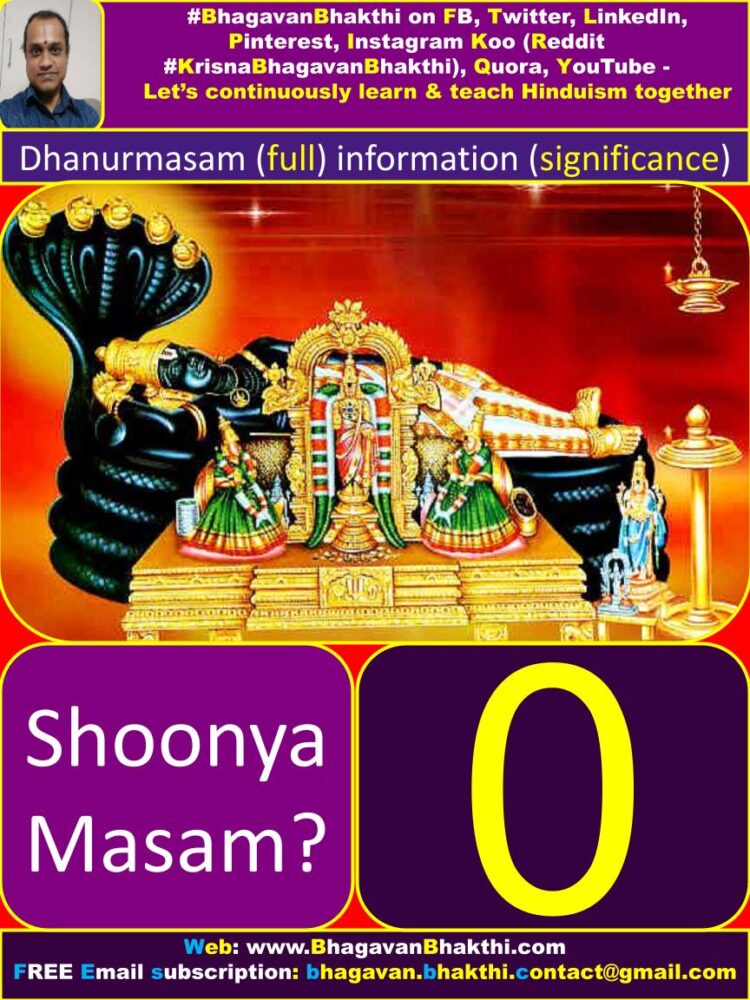
Dhanurmasam 2023 – 2024 start and end dates are as given here : December 16th 2023 – January 13th 2024
Dhanurmasam meaning : Dhanurmasam or Dhanurmaas or Dhanurmasa corresponds to the zodiacal sign of धनु राशि (dhanu rāśi) (Sagittarius).
And this dhanu rashi (Sagittarius zodiac) overlaps roughly with the second half of December month and with the first half of January month in the present Gregorian calendar.
Thus, when Surya / Sun transits into Dhanus (Dhanu) Rashi (Sagittarius) that month is represented as ‘Dhanur Masam’ (Dhanur Month).
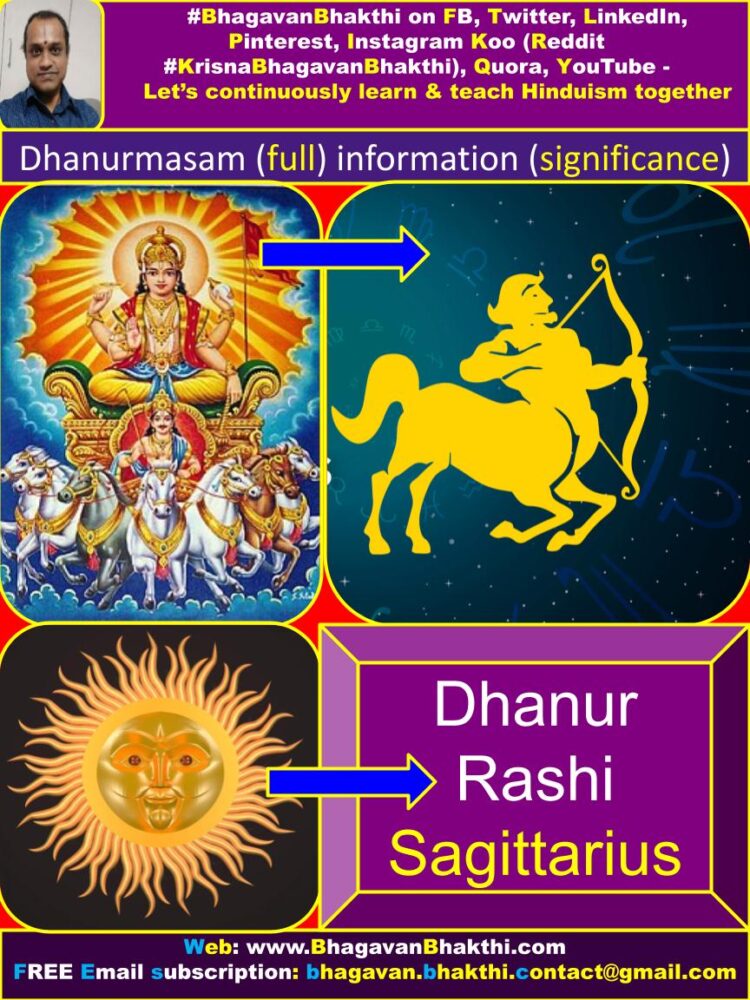
Hindu Sanatana Dharma (Hinduism) (सनातन धर्म) (sanātana dharma) is always right since the unknown time.
If we follow the Hindu Sanatana Dharma as prescribed as per our granthas (Divine Hindu Texts), we will definitely earn both material and spiritual benefits for both long and short term.
Each of the masam (maas) (masa) (mas) (month) of Hindu Panchanga (calendar) is auspicious and is dedicated to perform one or more particular ceremonies, rituals, customs, practices, etc.
Hindu Sanatana Dharma is the most diversified structure of thought marked by various divine philosophies and shared methodology, rituals, pilgrimage sites, concepts, cosmological systems, etc.
Also, Hindu Sanatana Dharma has the shared textual sources that discuss Vedas, Mahabharata, Ramayana, Puranas, Temple building, Yoga, Yagna, etc.
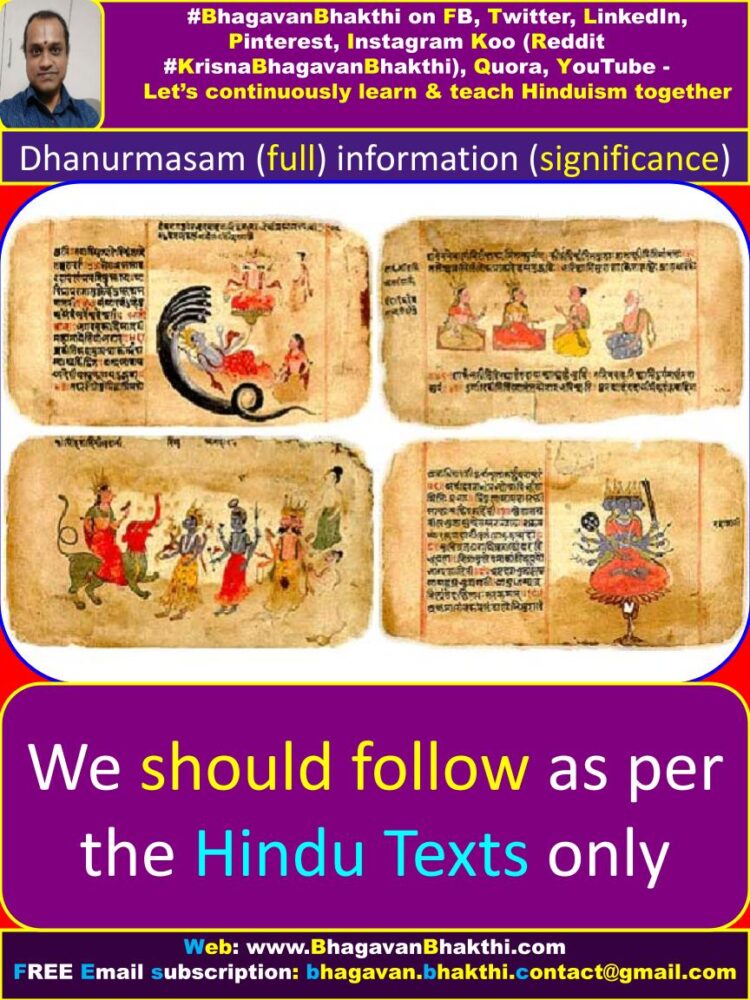
Most importantly the Hindu Sanatana Dharma include the ‘Chatur Puruṣārthas’ (Four Purusharthas) (Four goals of life) as given below:
The correct and required goals and / or aims of ‘manushya jaati’ (Human life) are: 1. Dharma : Duties as prescribed in Hindu granthas / texts), 2. Artha : Aim of life / Spiritual development etc.),
3. Kama : Expectations / desires), and 4. Moksha / Mukti : Divine liberation – This means freedom from the cycle of deaths and births, that is, going to the most auspicious planet called Vaikuntha permanently (forever).
With these ‘Chatur Purusharthas’, there are another two basic spiritual properties which are very important and they are as given below:
Karma : The actions performed or intent and its consequences, and Saṃsāra (Sansar) : cycle of deaths and births / reincarnation.

[Note : We should always remember that Sansar (Samsara) is different and Parivar (family) is different.]
[Sansar or Samsara means from the time of our birth and until our death. Whereas Parivar means our family, that is, wife, children, mother, father, brothers, sisters, relatives, etc.]
Hindu Sanatana Dharma always suggests the divine eternal duties (Karmas) as given below:
To have honesty through the life, should always avoid injuring other living beings (i.e., practicing ahiṃsā), patience, tolerance (up to some level), self-control, morality, and sympathy etc.
Hindu Sanatana Dharma divine practices include ceremonies and rituals like doing the following:
Daily pooja (worship) and need to recite different stotrams (slokas) (shlokas) regular as prescribed in Hindu Granthas (Texts).
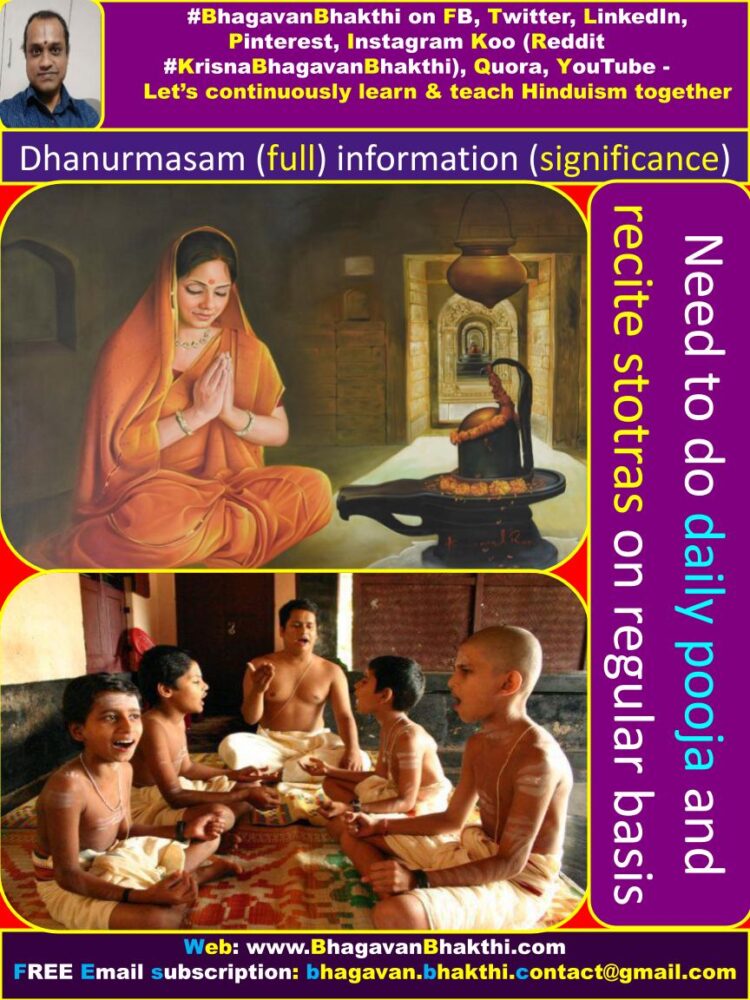
And also to do japa (जप), tapa (तप), divine meditation (dhyāna of Lord Sri Vishnu), as per all the festivals every year, and to have consistent pilgrimages through out India through our life term.
In Hindu Sanatana Dharma, we mainly find two types of ‘panchangas’ / calendars being followed as given below:
1. Sauramana Panchanga (सौरमान पंचांग) (sauramāna pan̄cāṅga) / Solar Calendar and 2. Chandramana Panchanga (चंद्रमान पंचांग) (candramāna pan̄cāṅga) / Lunar Calendar.
In Sauramana Panchanga / Solar Calendar the months are derived from the names based on the transit of Surya / Sun in a particular rashi (zodiac) sign.
Whereas, in Chandramana Panchanga / Lunar Calendar it is based on the Nakshatras / Constellations occurring on the ‘Purnima tithi’ (Full moon day).

The period between two successive Sankramana / Solar transits or the time taken by the Surya / Sun to pass through a rashi (zodiac) sign is known as a Solar month.
Thus, when Surya / Sun transits into Dhanus (Dhanu) Rashi (Sagittarius) that month is represented as ‘Dhanur Masam‘ (Dhanur Month).
This will mark the entry of Surya / Sun into Dhanus (Dhanu) rashi and it is called as ‘Dhanus (Dhanu) Sankramana‘ (Transit of Dhanur Rashi).
This generally occurs around the mid of the winter month of December as per Gregorian Calendar.
Dhanur Masam generally occurs in between the two Chandramana / Lunar months called ‘Mārgaśirṣa / Agrahāyaṇa‘ and ‘Pushya‘.
As per the Gregorian / English Calendar, Dhanur masam generally starts somewhere around on 16th of December (Gregorian calendar) and ends on January 13th or 14th on the Bhogi festival day.
It is the ninth month (Mārgaśirṣa / Agrahāyaṇa) of the zodiac starting from ‘Mesha Rashi’ (Aries) and is the last month before the onset of Uttarayana (Uttarayan) (उत्तरायण) (uttarāyaṇa).
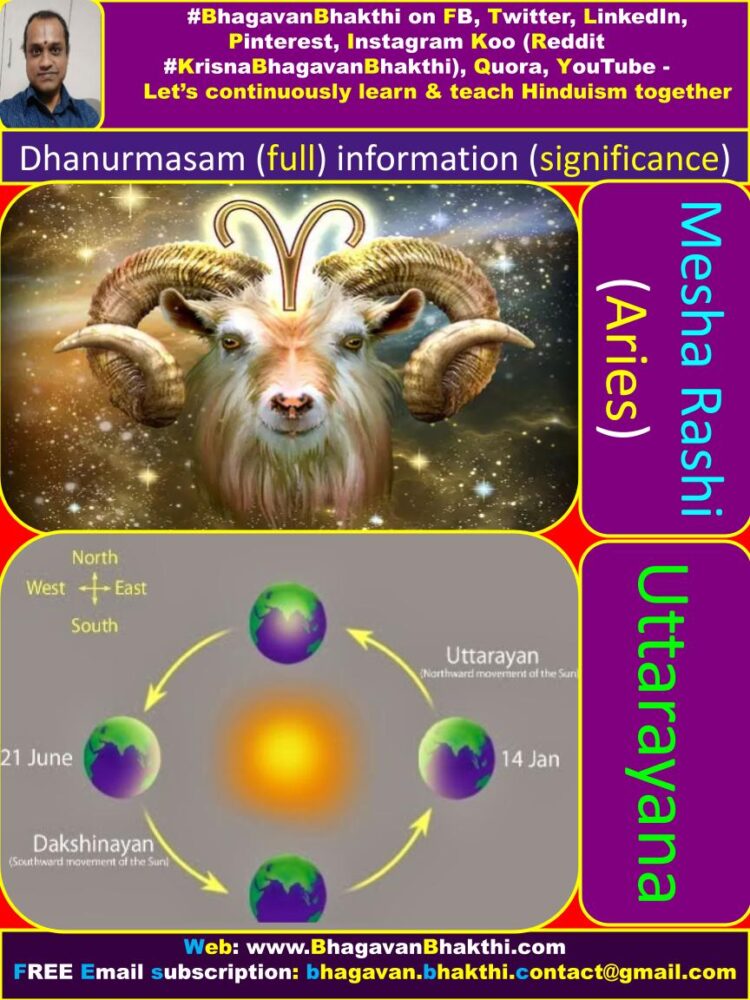
Dhanur masam has acquired a distinctive importance and auspiciousness in Hindu Sanatana Dharma spiritual calendar for devotional activities especially worshiping of Lord Sri Maha Vishnu.
Lot more importance is given in worshipping Lord Sri Vishnu in Dhanur masam during the early hours before Sunrise known as ‘Arunodaya Kaalam‘ (अरुणोदय काल) (aruṇōdaya kāla).
(Arunodaya Kaalam means much before the Sunrise. Aruna is the charioteer of Lord Sri Surya Deva / Sun God. First Arjuna rises in the early morning before his Lord Sri Surya Deva and thus this time is known as Arunodaya Kaalam).
In this month of Dhanur masam, one is expected to discharge ceremonies during the auspicious ‘Brahmi Muhurtam’, that is, approximately two hours before the Sunrise when the stars are still shining in the akasham / sky.
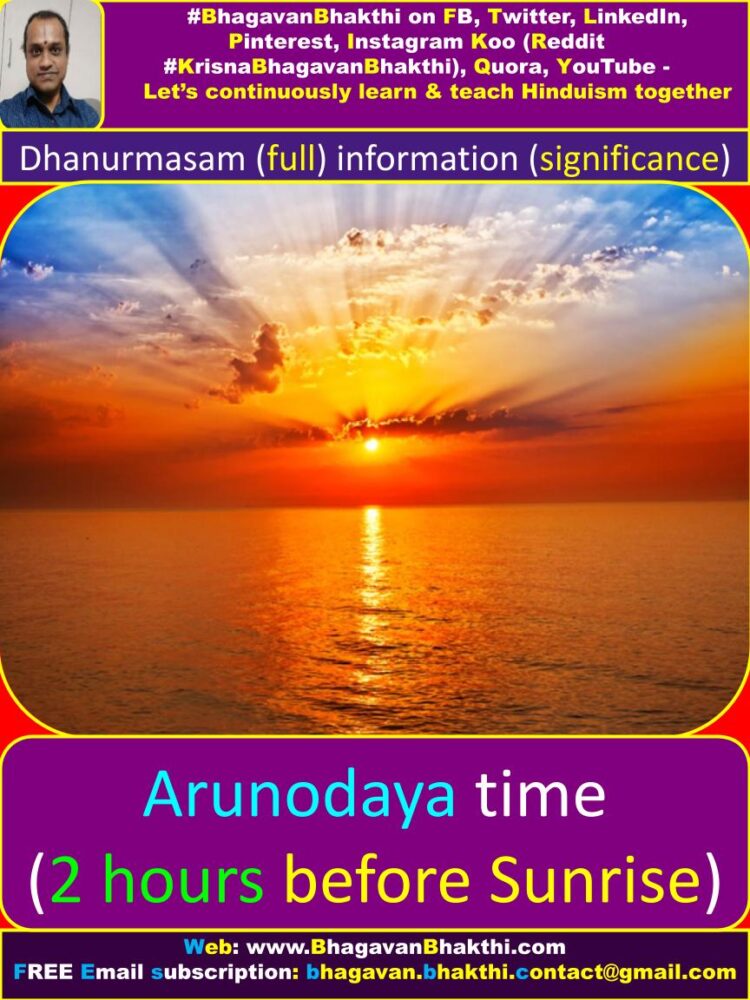
In the Dhanur masam a distinctive divine dish is prepared with Rice and Moong dal mixed in equal proportions is offered to Lord Sri Vishnu as Naivedyam (नैवेद्य) (naivēdya) (Bhog).
What is Huggi Neivedya: This divine dish uses Green gram, that is, मूंग दाल / Moong dal or ಹೆಸರು ಬೇಳೆ / Hesaru Bele and rice as the primary ingredients.
What is the proportion of Moong dal and Rice: Agnya (Agni) Purana shlokas as given below for the preparation of this food:
मुद्गं तंडुलमानं स्याद्युत्तमोत्तममुच्यते । मध्यमं तंडुलादर्धं तदर्धमधमं भवेत्। मुद्गं तु द्विगुणं केचित् प्रशंसंति मुनीश्वरा: । यथाबलं प्रकुर्वीत न हीयेत्तंडुलार्धत: ।
ಮುದ್ಗಂ ತಂಡುಲಮಾನಂ ಸ್ಯಾದ್ಯುತ್ತಮೋತ್ತಮಮುಚ್ಯತೇ | ಮಧ್ಯಮಂ ತಂಡುಲಾದರ್ಧಂ ತದರ್ಧಮಧಮಂ ಭವೇತ್ | ಮುದ್ಗಂ ತು ದ್ವಿಗುಣಂ ಕೇಚಿತ್ ಪ್ರಶಂಸಂತಿ ಮುನೀಶ್ವರಾ: | ಯಥಾಬಲಂ ಪ್ರಕುರ್ವೀತ ನ ಹೀಯೇತ್ತಂಡುಲಾರ್ಧತ: |
mudgaṁ taṇḍulamānaṁ syādyuttamōttamamucyatē | madhyamaṁ taṇḍulādardhaṁ tadardhamadhamaṁ bhavēt | mudgaṁ tu dviguṇaṁ kēcit praśansanti munīśvarā: | yathābalaṁ prakurvīta na hīyēttaṇḍulārdhata: |
Meaning of this shloka is as given her : Hindu Sanatana Dharma shastras rate the most divine naivedyam (bhog) based on the proportion of Green gram to rice in the mudganna.
The naivedyam is rated as ultimate and supreme if the ratio of green gram and rice is 2:1. Naivedyam is good if 1:1, Naivedyam is medium if 1:2 and Naivedyam is lowest if 1:4 or lower.
In our Puranas it is said that Lord Sri Indra Deva‘s consort Sri Shachi Devi, offered such ultimate and supreme mudganna mixed with ginger to Lord Sri Vishnu and got rid of her all troubles.
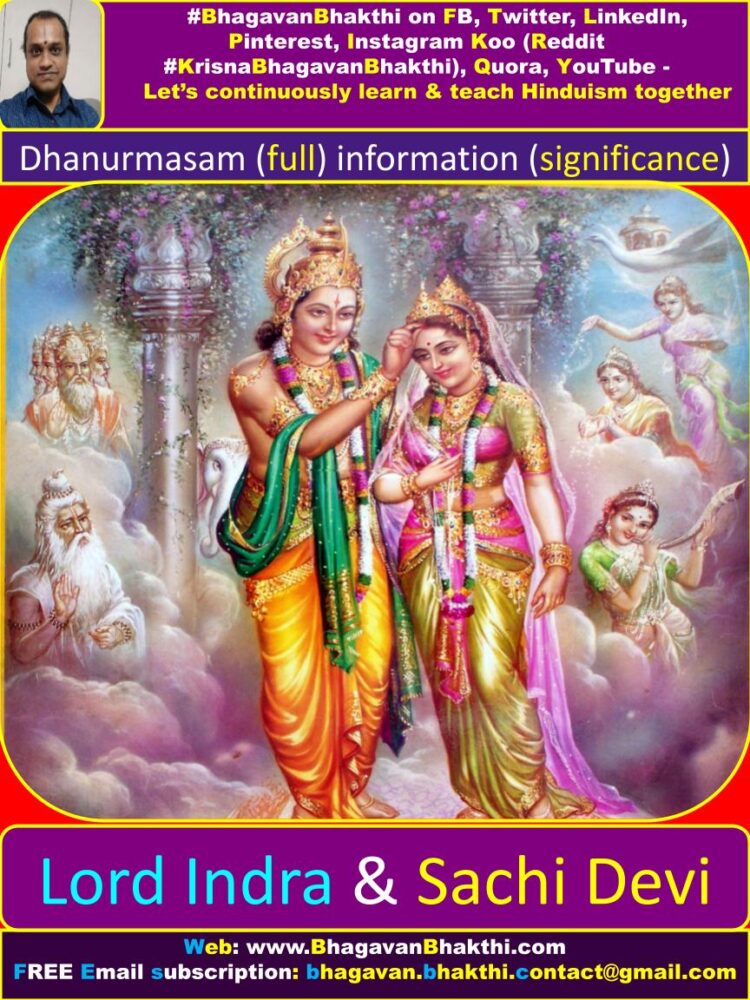
What are the advantages of Huggi (Mudganna) neivedyam (bhog) is as given below:
दध्यार्दकं च मुद्गान्नं दद्याच्चैलागुडोज्ज्वलम् । सुसुखोष्णं सकंदं च विष्णवे य: समर्पयेत् । दृष्ट्वा तच्चुभमुद्गान्नं संतुष्टो भक्तवत्सल: । ददाति सकलान् भोगान् मोक्षं च जगदीश्वर: ।
ದಧ್ಯಾರ್ದಕಂ ಚ ಮುದ್ಗಾನ್ನಂ ದದ್ಯಾಚ್ಚೈಲಾಗುಡೋಜ್ಜ್ವಲಮ್ | ಸುಸುಖೋಷ್ಣಂ ಸಕಂದಂ ಚ ವಿಷ್ಣವೇ ಯ: ಸಮರ್ಪಯೇತ್ | ದೃಷ್ಟ್ವಾ ತಚ್ಚುಭಮುದ್ಗಾನ್ನಂ ಸಂತುಷ್ಟೋ ಭಕ್ತವತ್ಸಲ: | ದದಾತಿ ಸಕಲಾನ್ ಭೋಗಾನ್ ಮೋಕ್ಷಂ ಚ ಜಗದೀಶ್ವರ: |
dadhyārdakaṁ ca mudgānnaṁ dadyāccailāguḍōjjvalam | susukhōṣṇaṁ sakandaṁ ca viṣṇavē ya: Samarpayēt | dr̥ṣṭvā taccubhamudgānnaṁ santuṣṭō bhaktavatsala: | dadāti sakalān bhōgān mōkṣaṁ ca jagadīśvara: |
Meaning of this shloka is given here : If we offer Mudganna as naivedyam (bhog) to Lord Sri Vishnu in the right proportion,
Lord Sri Vishnu will definitely be pleased and will fulfill all our requirements and also he will finally give Moksha to us.
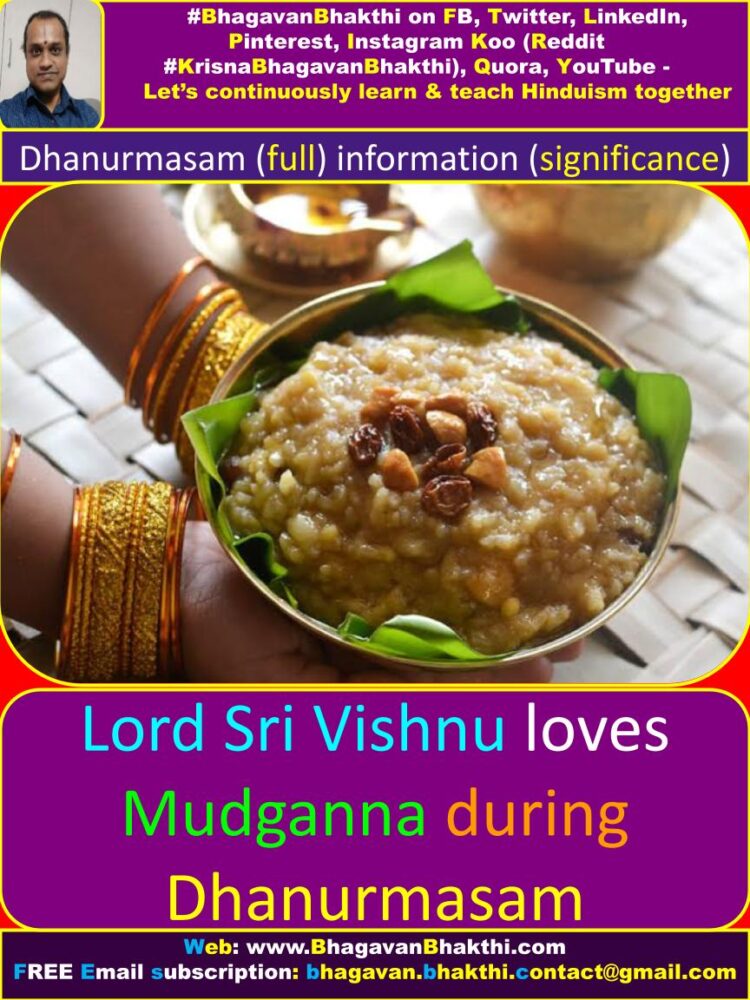
Very high significance is given to Dhanur masam in ‘Vaishnava Sampradayam / tradition‘ and all the Lord Sri Vishnu linked devalayas / temples perform sacred rituals and poojas early in the morning during this Dhanur Masam / month.
We can easily find temples offering Sweet Pongal, Khara Pongal, and Puliyogare as Naivedya (Bhog) to Lord Sri Vishnu and distributing the same as divine prasadam to all his devotees during Dhanur masam.
Health related significance (importance) about the Dhanur Masam prasadam is as given below:
There is also a great health related significance (importance) with these divine food items (prasadam) during Dhanur masam.
At Tirupati, the divine abode of Lord Sri Venkateswara (Srinivasa) (Balaji), we find the priests reciting ‘Tiruppavai‘, that is –
A divine song composed by ‘Sri Godadevi‘ (Also called as Andal Devi) who was an ardent devotee of Lord Sri Krishna, instead of the usual ‘Suprabhatham‘ in the early morning.
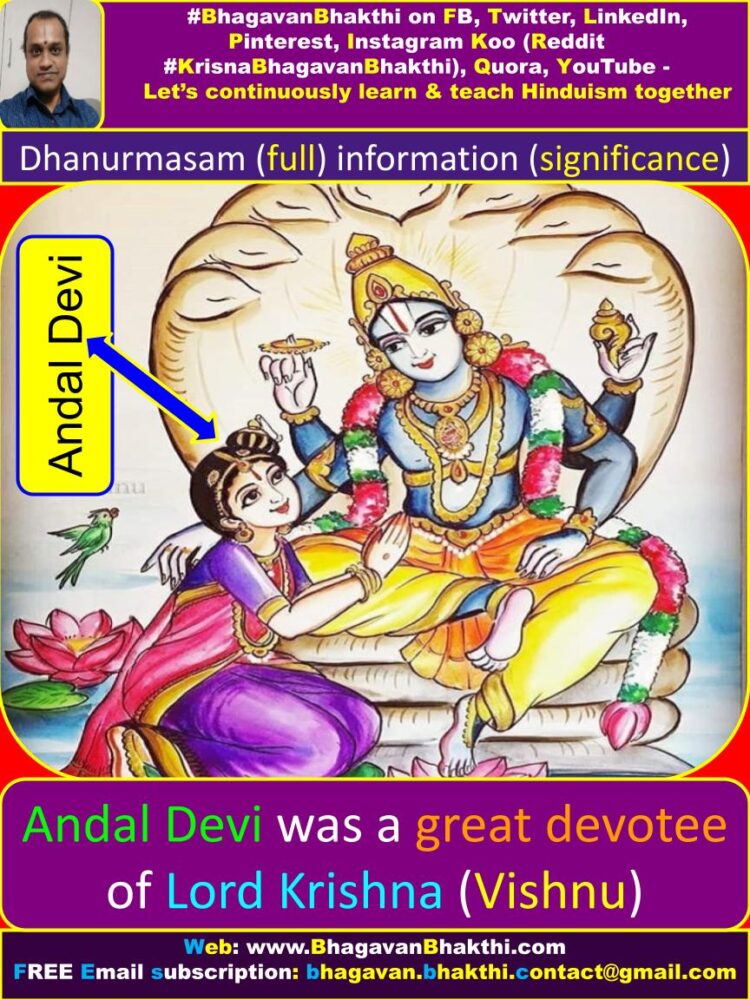
At Tirumala temple of Lord Sri Venkateswara (Srinivasa) (Balaji) is worshiped daily with Bilva leaves (Bael / Bilva Patra) during Dhanur masam.
It is highly meritorious to chant the most divine Purusha Suktam, Sri Vishnu Sahasra Nama Stotram, Sri Vishnu Suktam and Narayana Upanishad during this divine period of Dhanur masam.
Worshiping Goddess Sri Lakshmi Devi along with Lord Sri Vishnu is also prescribed during Dhanur masam. If we worship only Goddess Sri Lakshmi Devi and don’t worship Lord Sri Vishnu, then it will product opposite effects (negative effects).
Instead, we should always worship Lord Sri Vishnu first and then Goddess Sri Lakshmi Devi as prescribed in the Hindu Sanatana Dharma granthas (texts).
Shukla Paksha Ekadashi (either in Mārgaśirṣa / Agrahāyaṇa’ or ‘Pushya masam) associated with Dhanur masam is revered as Vaikuntha Ekadashi or also called as Mukkoti Ekadashi.

This is the most divine day to worship Lord Sri Vishnu. Next day of Dwadashi day is known as Mukkoti Dwadashi. Vyatipata yoga during Dhanur masam (Dhanur-Vyatipata Yoga) is given high importance.
And it is believed that any Pitru Karya (forefathers rituals) or charity given in respectful reverence to one’s Pitrus on this auspicious day is considered as highly meritorious and divine.
As prescribed in ‘Sri Venkatachala Mahatmya’ (श्री वेन्कटाचल महात्म्य) (śrī veṅkaṭācala mahātmya), it is said that, –
Taking bath in Sri Swamy Pushkarini Tirtham (pond) at Tirumala (Tirupati) on the day of Shukla Paksha, Dwadashi tithi (That is on Mukkoti Dwadashi) in the month of Dhanur masam during ‘Arunodaya kalam‘ is considered as highly divine.
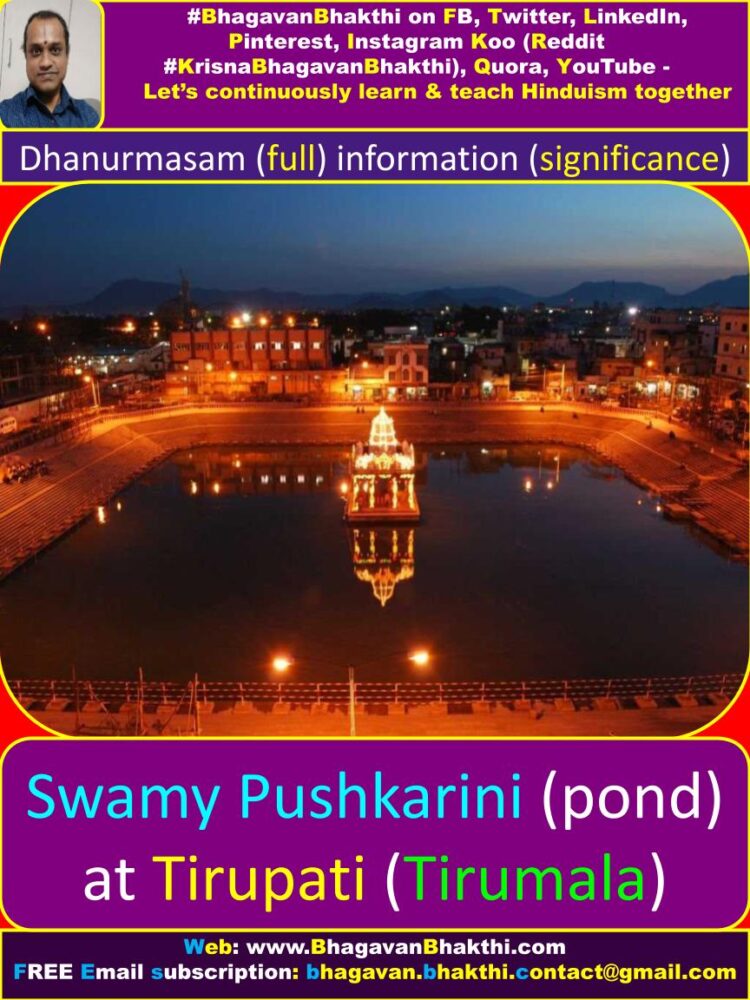
On this Shukla Paksha, Dwadashi tithi / day it is said that, more then three crores of sacred tirthas (rivers) in the entire Bhulokam (earth) will enter into this Sri Swamy Pushkarini pond at Tirupati (Tirumala).
Taking the divine bath on this day in Swami Pushkarini is observed as highly meritorious and this is equivalent to taking bath in all the three crores of sacred tirthas (rivers).
It is revered as Sri Swamy Pushkarini Tirtham Koti day in the almanac of Tirupati (Tirumala) Devalaya / temple.
Why auspicious functions like marriage, naming ceremony, griha pravesh and other functions should not be performed on Dhanurmasam?
This is because as per the Hindu Texts (Granthas) we need to give more importance about worshipping Lord Sri Vishnu in Dhanurmasam and should focus only about the auspicious worships, rather than worldly activities.
This is the reason, the supremacy, sacredness and spirituality attached to the Dhanur masam, auspicious functions like marriage, naming ceremony, Griha Pravesh, etc. should be 100% avoided during this month of Dhanur masam.
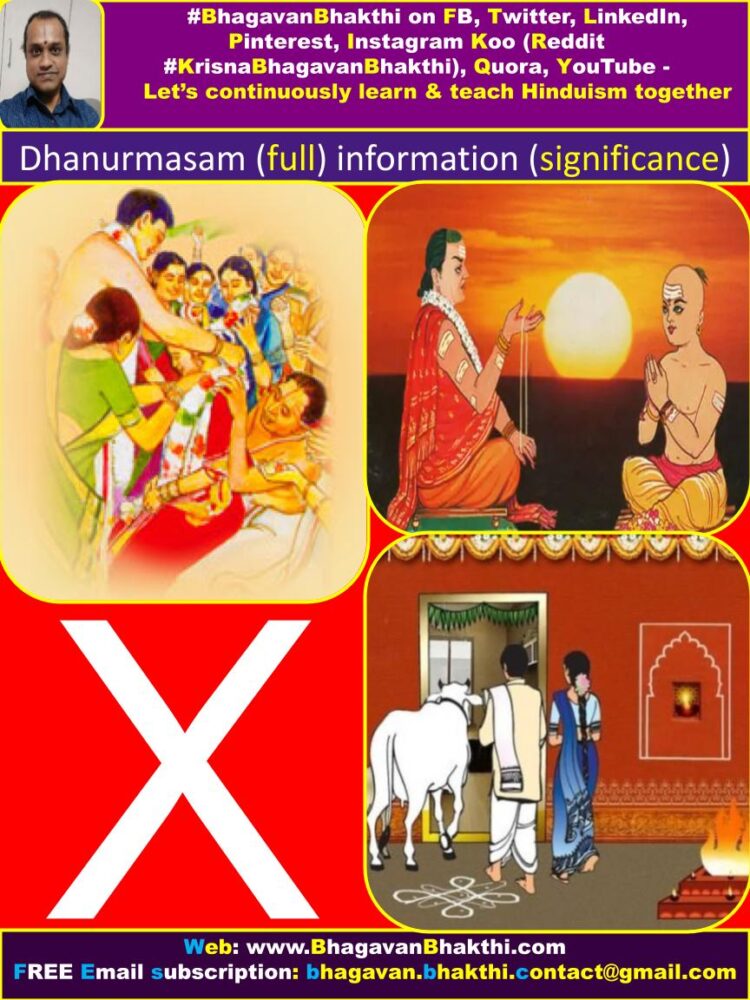
(This is just like a student has to give 100% importance to studies only during the examination period and not at all think about other activities, if he / she has to score maximum marks in the exams.)
During Dhanur masam, why only Arunodaya kalam (early morning) is prescribed for worshiping Lord Sri Vishnu?
As per the theory (Hindu Texts) of Hindu Sanatana Dharma time element, it is said that, one day (Day + Night) for Devatas / Demigods is same and equal to one human year (365 days).
This whole one year of 365 days includes 6 months of Uttarayana and 6 months of Dakshinayana. That means, Uttarayana is the day time for Devatas / Demigods and Dakshinayana is the night time for Devatas / Demigods.
Thus, accordingly one human month (30 days + 30 nights) is equal to two hours for Devatas / Demigods as per their lokas (planets) timings.
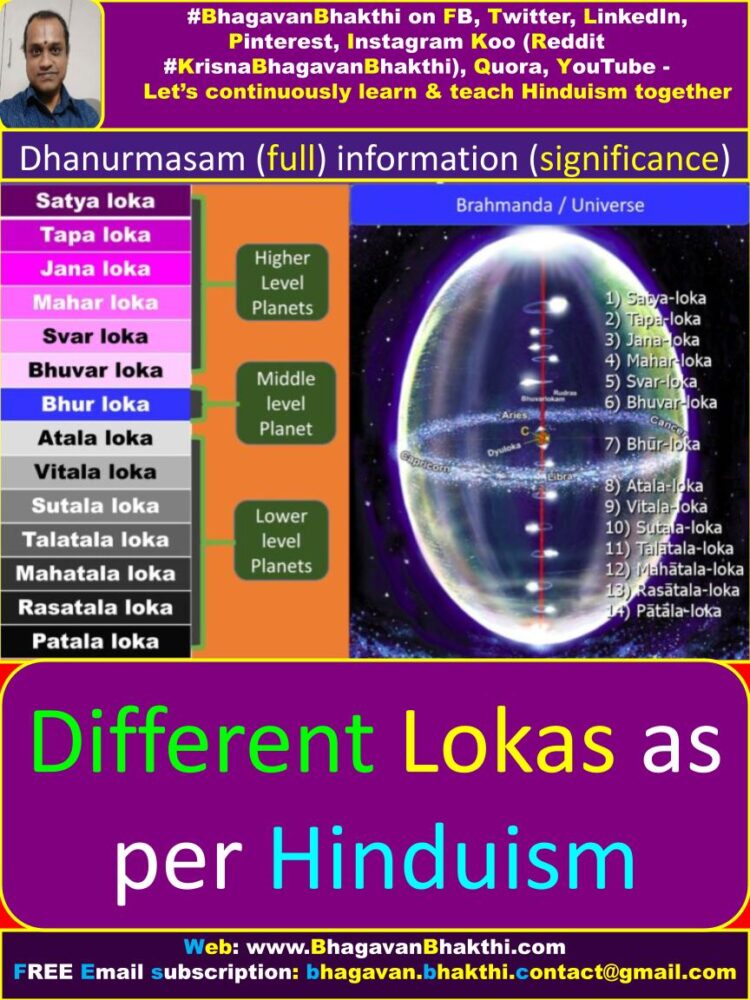
The period of Dhanur masam falling at the fag end of Dakshinayana, shows the last time frame of the night time for Devatas (Demigods), that is, Arunodaya kalam (early morning) time (for earthly people / us) when they worship Lord Sri Vishnu.
For this reason, we humans also need to worship Lord Sri Vishnu at a time that coincides with the Arunodaya Kaalam for Devatas / Demigods.
This coincidentally matches with the Dhanur masam timings. Thus, this is the auspicious period and it is known as Arunodaya kalam or Brahmi Muhurtam (early morning time).
Any pooja / worship conducted during Arunodaya kalam (early morning – 2 hours before Sunrise) is said to be of highest divinity and this yields meritorious results for us.
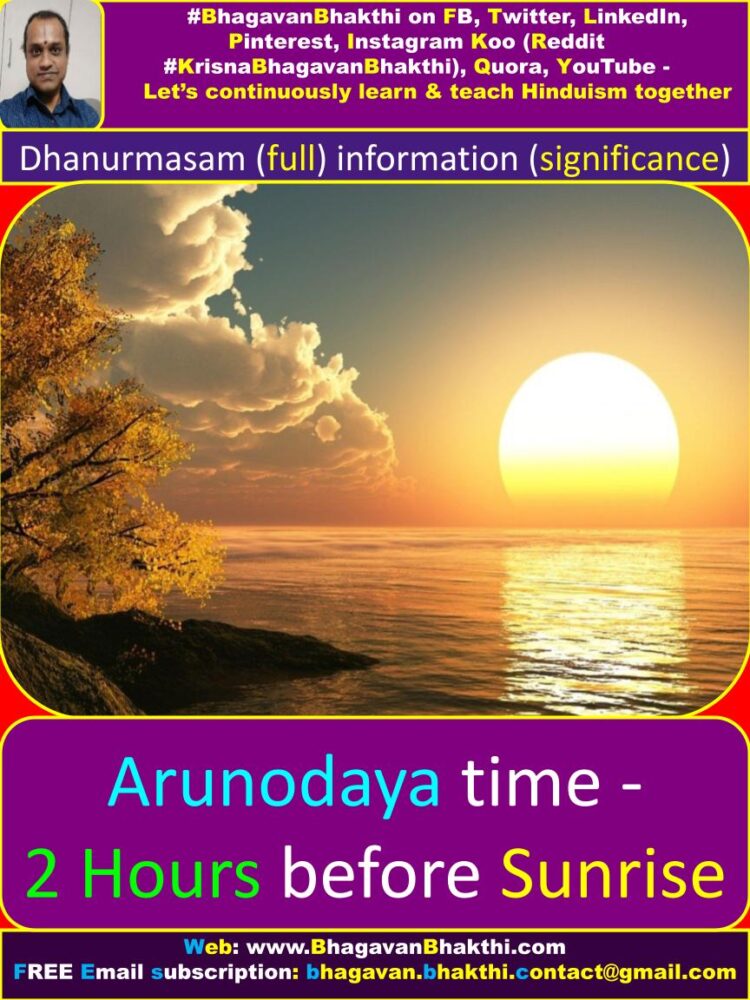
It is said in our Hindu Sanatana Dharma Shastras (Hindu Texts) that doing pooja / worshiping Lord Sri Vishnu as meritorious and divine period of Dhanur masam, that is –
The dearest month for Lord Sri Vishnu even for a single day is equivalent to worshiping the Lord Sri Vishnu for 1000 years during other days.
In Hindu Sanatana Dharma Shastras (Hindu Texts) for everything a specific time frame and measurement is set and prescribed according to the theory of time element.
Hindu Sanatana Dharma Shatras (Hindu Texts) specifies the unique significance given to the particular masam / month, dina / day, tithi, Nakshatram, etc.
Thus and therefore performing correct Karmas at the right time and seeking divine blessings that yields more better and better results is intelligence.
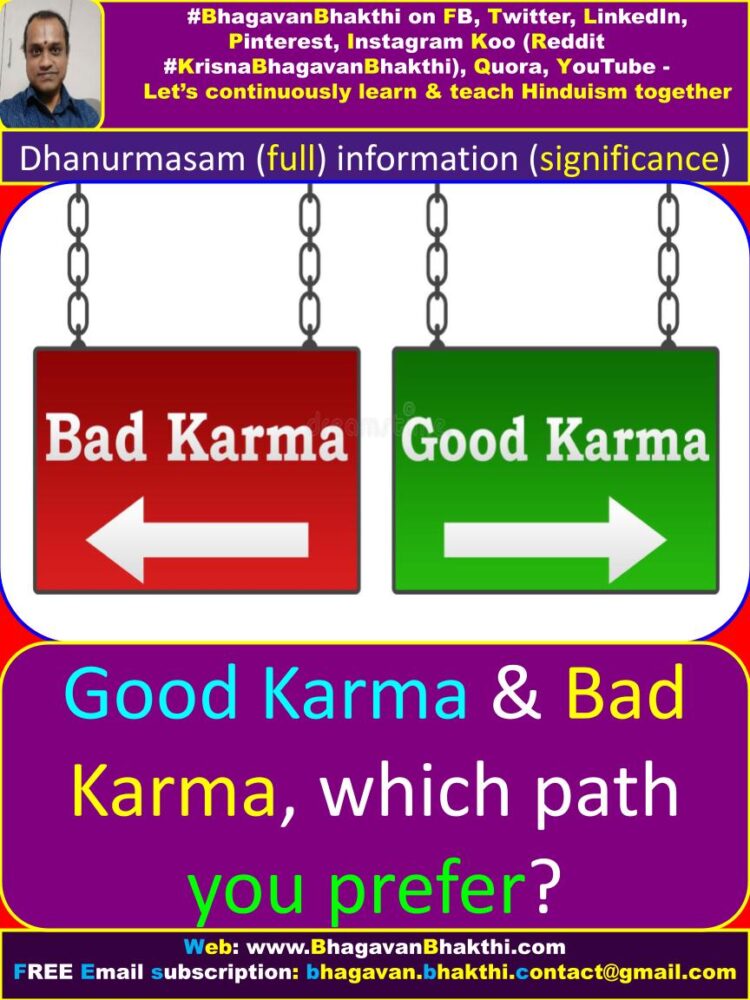
Different fruits (phalas) if the pooja done during dhanurmasam is as given below:
This below shloka is as given in Agneya (Agni) Purana. It states that:
मुख्यारुणोदये पूजा मध्यमा लुप्ततारका । अधमा सूर्यसहिता मध्याह्ने निष्फला भवेत् ।
ಮುಖ್ಯಾರುಣೋದಯೇ ಪೂಜಾ ಮಧ್ಯಮಾ ಲುಪ್ತತಾರಕಾ | ಅಧಮಾ ಸೂರ್ಯಸಹಿತಾ ಮಧ್ಯಾಹ್ನೇ ನಿಷ್ಫಲಾ ಭವೇತ್ |
mukhyāruṇōdayē pūjā madhyamā luptatārakā | adhamā sūryasahitā madhyāhnē niṣphalā bhavēt |
Meaning of this shloka is as given here : One has to complete the pooja / worship when the stars are still twinkling in the sky, that is, during the Arunodaya kalam (early morning).
This is the best time to do pooja / worship. Whereas if the pooja / worship that is done after the stars have disappeared, but before sunrise, it is considered somewhere as medium.
Also, similarly the pooja / worship that is completed after sunrise is inferior. And if the pooja / worship done in the afternoon is realistically useless. We have to do the pooja / worship and naivedyam (bhog) at least 96 minutes before sunrise.

Consequences of not doing the pooja / worship in time during Dhanurmasam is as given below:
As per Agneya (Agni) Purana: यस्तु दारिद्र्यबुद्द्या मुद्गान्नं न निवेदयेत् । विष्णवे कार्मुके प्रात: सप्तजन्मसु निर्धन: ॥
ಯಸ್ತು ದಾರಿದ್ರ್ಯಬುದ್ದ್ಯಾ ಮುದ್ಗಾನ್ನಂ ನ ನಿವೇದಯೇತ್ | ವಿಷ್ಣವೇ ಕಾರ್ಮುಕೇ ಪ್ರಾತ: ಸಪ್ತಜನ್ಮಸು ನಿರ್ಧನ: ||
yastu dāridryabuddyā mudgānnaṁ na nivēdayēt | viṣṇavē kārmukē prāta: Saptajanmasu nirdhana: ||
Meaning of this shloka is has given here: We who does not perform the pooja / worship of Lord Sri Vishnu in time (As said above), that is –
before Sunrise will get dāridrya (indigence / extreme poverty) during his / her next seven lives, as well he / she will suffer from diseases and his mental strength will be highly limited.
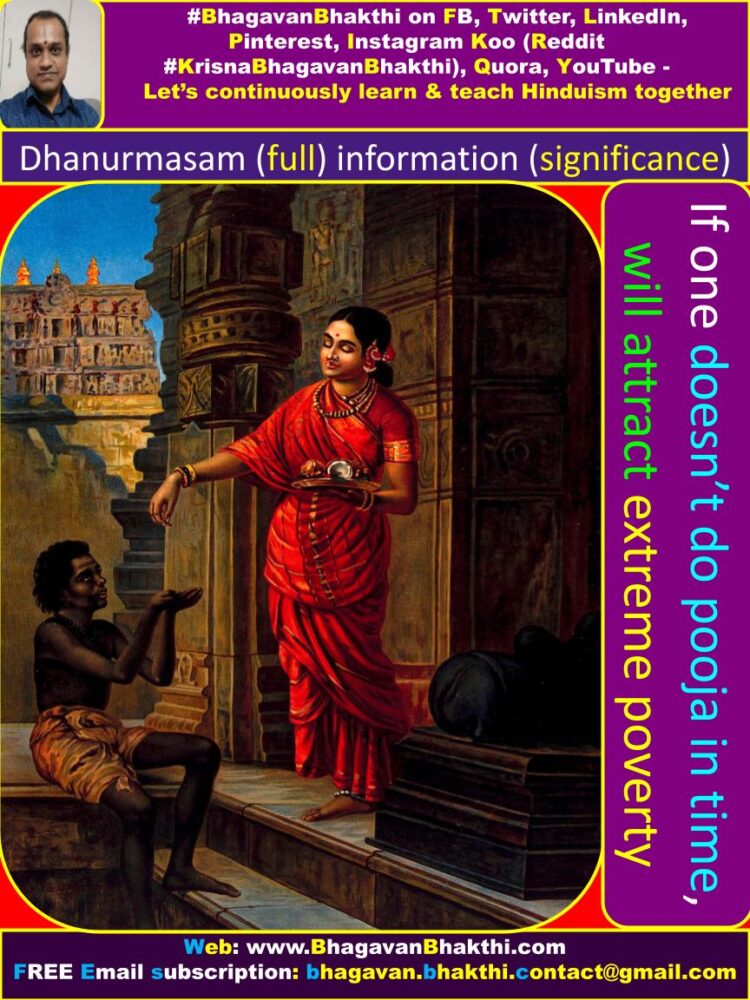
Dos and Don’ts during the Dhanurmasam is as given below:
1. Doing pooja / worshipping Lord Sri Vishnu, Goddess Sri Lakshmi Devi and other Devatas / Demigods as per the hierarchy / taratamya.
[Here hierarchy / taratamya means, starting from Lord Sri Vishnu, Goddess Sri Lakshmi Devi, Lord Sri Brahma Deva, Goddess Sri Sarasvati Devi, Lord Shiva, Goddess Sri Parvati Devi, Lord Sri Indra Deva, Lord Sri Kama Deva, Lord Sri Surya Deva, Lord Sri Chandra Deva, and other Devatas (Demigods).]
2. To recite ‘Sri Vishnu Sahasra Nama Stotram‘ + Purusha Suktam.
3. Offering Naivedya (Bhog) to Lord Sri Vishnu as prescribed in the Hindu Shastras (Texts).
4. To observe nirjala upavasam (fast, even not drinking a drop of water) on Vaikuntha Ekadashi day.
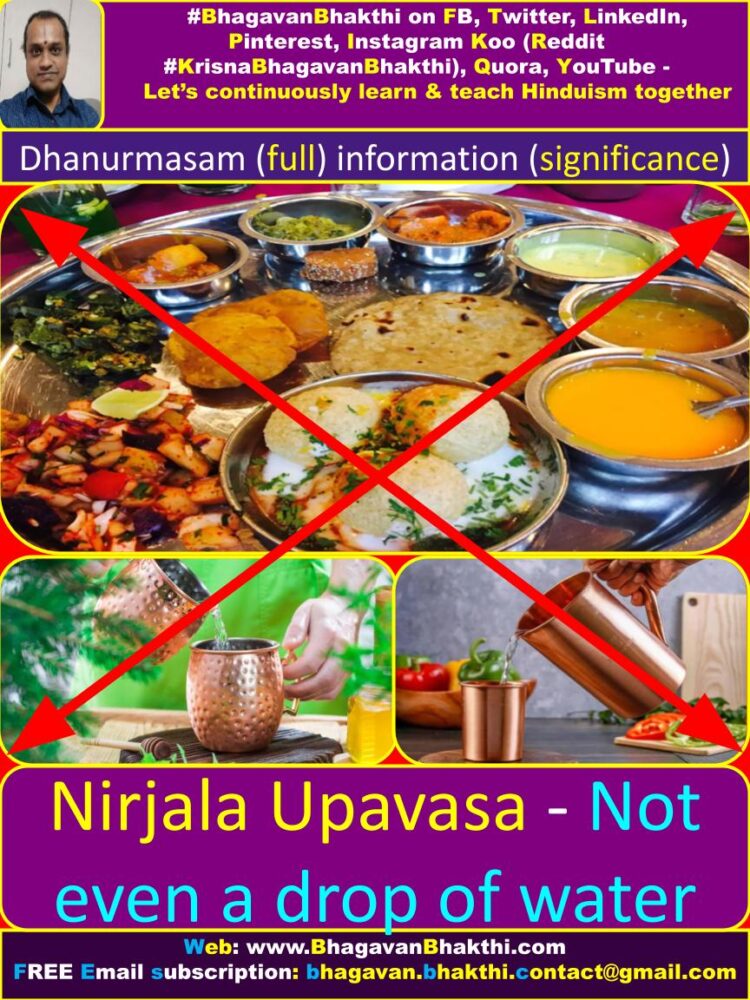
5. To perform Pitru Karyas (Forefather rituals) on the day of Dhanur Vyatipata Yoga.
6. To avoid performing all the auspicious functions like marriage, naming ceremony, griha pravesham, etc. during the Dhanur masam.
7. Performing pooja rituals during Arunodaya Kalam (early morning), that is, two hours before Sunrise.
Advantages of performing pooja / worship of Lord Sri Vishnu during Dhanurmasam is as given below:
कोदंडस्थे सवितरि प्रत्यूष: पूजनाद्धरे: । सहस्राब्धार्चनफलं दिनेनैकेन लभ्यते ॥
ಕೋದಂಡಸ್ಥೇ ಸವಿತರಿ ಪ್ರತ್ಯೂಷ: ಪೂಜನಾದ್ಧರೇ: | ಸಹಸ್ರಾಬ್ಧಾರ್ಚನಫಲಂ ದಿನೇನೈಕೇನ ಲಭ್ಯತೇ ||
kōdaṇḍasthē savitari pratyūṣa: pūjanād’dharē: | sahasrābdhārcanaphalaṁ dinēnaikēna labhyatē ||
Meaning of this shloka is as given here: Someone who is doing the pooja / worship at least for one day in the early morning during Dhanur masam, will get the pooja’s good deeds which will be equal to 1000 years.
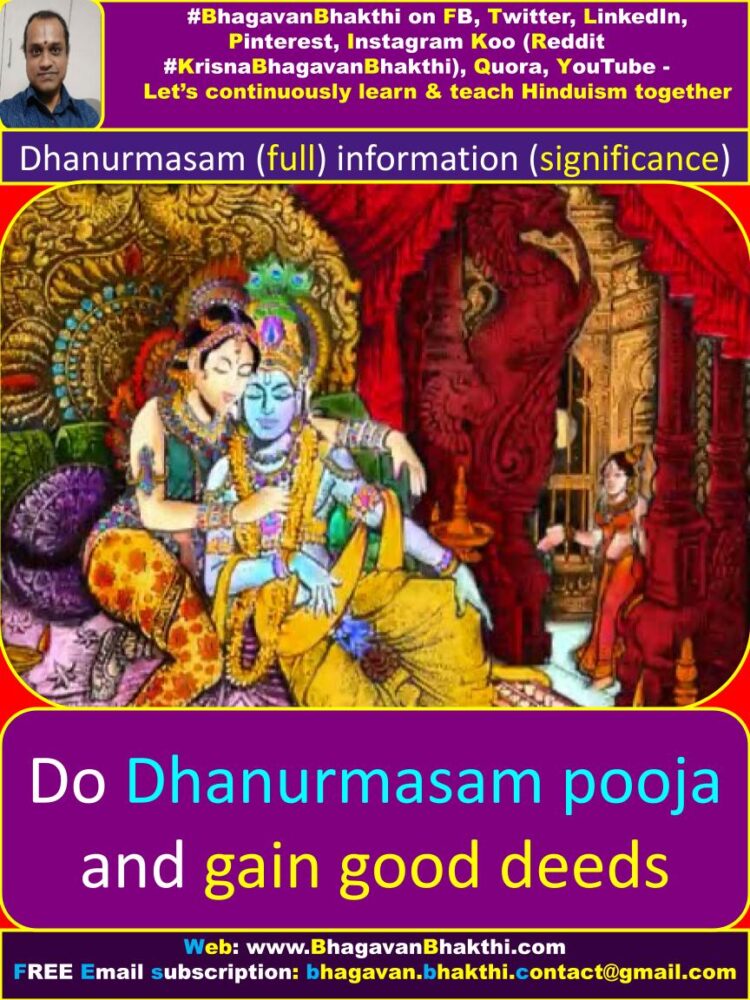
(We should note that, just doing the pooja / worship for one day is enough. No, it’s not like that. Here one day means not just one day, but one full month. We need to do the pooja / worship throughout the masam / month without fail.)
(Hindu Sanatana Dharma doesn’t restricts us to perform the pooja / worship for just a single day. If and only if we do the pooja / worship for the full month of Dhanur masam, we will get the full benefits / punyam.)
(A person who is performing the pooja / worship will get dhana (wealth), dhanya (food grains), and in all his births he will be born as a true Vaishnava.)
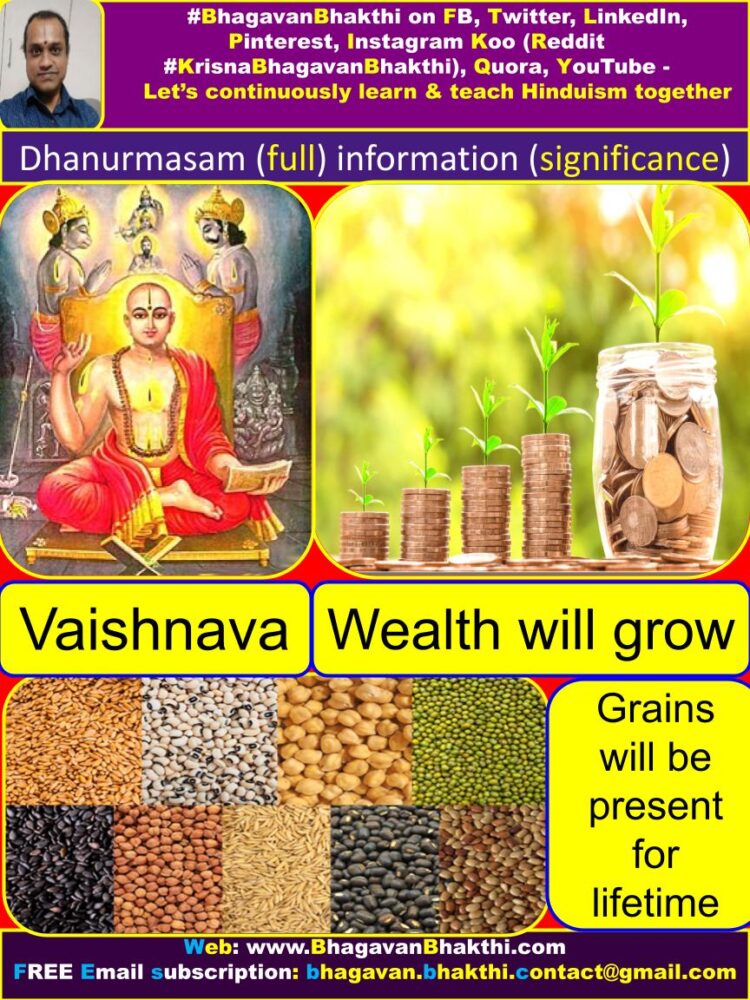
Should we have to eat the food before sunrise during Dhanurmasa?:
It’s not at all like that. He / she who is performing the pooja / worship and someone who is not performing the pooja / worship should never ever eat food before sunrise.
(Hindu Sanatana Dharma never allows someone to eat during the night time (probably after 10 p.m. and before Sunrise.)
(Even someone who is performing the Ekadashi fasting, has to eat food / drink water on Dwadashi after performing the pooja / worship after the Sunrise.)
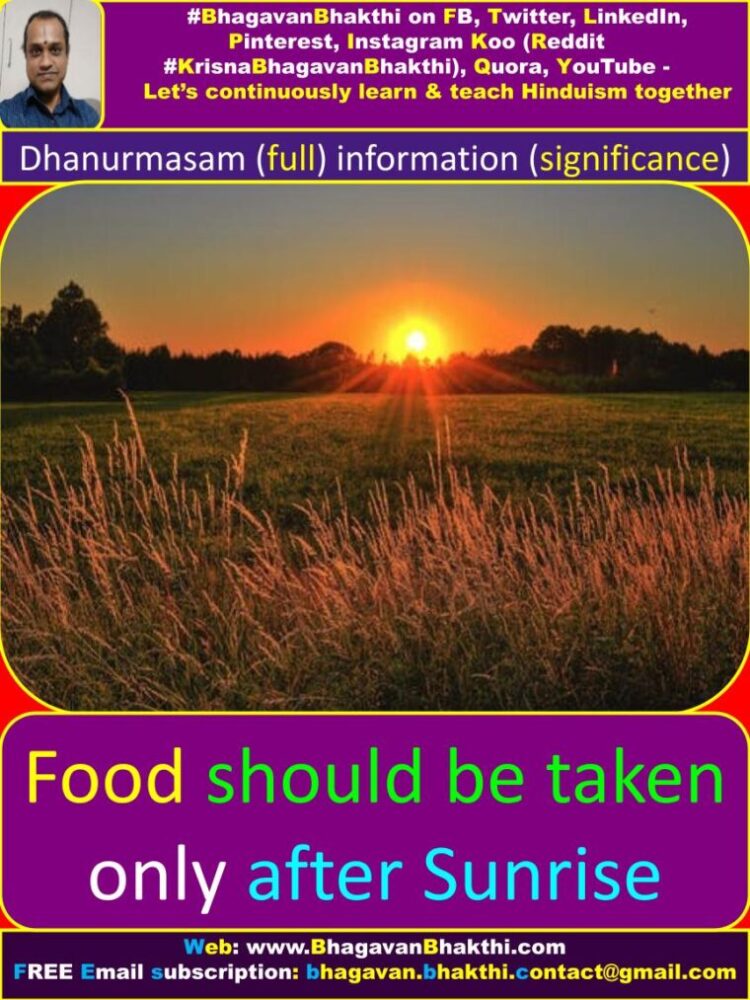
Information about performing Shraddha Karyas (Forefathers rituals) during Dhanur masam is as given below:
If someone is died during the Dhanurmasam, all the Pitru Karyas (Forefathers rituals) coming in this period must be done before Sunrise.
That person will get the punyam (good deeds) for having done the Shraddha only if he does it before Sunrise and not after Sunrise.
Why Dhanurmasam is also termed as Shoonya masam (शून्य मास) (śūn’ya māsa)? This whole masam / month is 100% reserved for Lord Sri Vishnu.
One has to perform the pooja / worship of Goddess Sri Lakshmi Devi along with Lord Sri Vishnu, that is, first pooja for Lord Sri Vishnu and second pooja is Goddess Sri Lakshmi Devi.
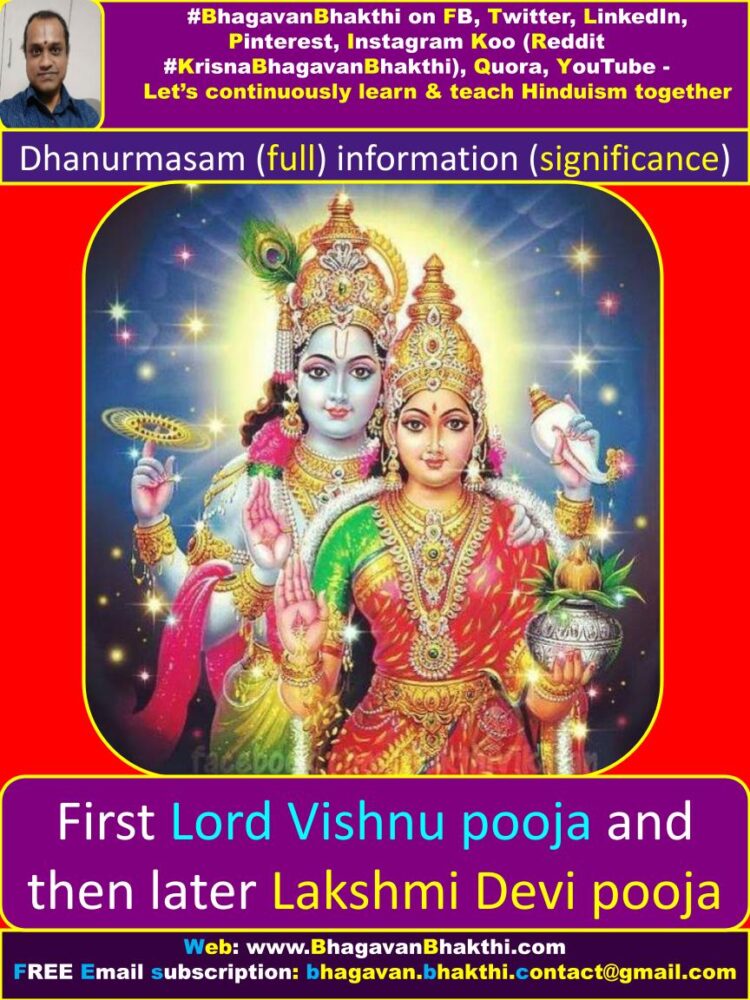
Thus to perform the pooja / worship of Lord Sri Vishnu, we have to 100% avoid other ‘Shubha Karyas‘ (Divine good works) in this month as said earlier.
This month is not favorable for performing any other good works like vivaham (marriage), upanayanam, gruha pravesham etc as said earlier.
If someone does these Shubha Karyas (Auspicious functions), that person will not get the punyam (good deeds) of Kanya daana in marriage and similarly no phala (fruit) will be gained if someone does upanayanam or any other Shubha Karyas.
Thus, one must not do any such Shubha Karyas (Auspicious functions) in this month of Dhanurmasam.

(We should always remember that, as this masam / month is exclusively only to perform pooja of Lord Sri Vishnu and thus for this reason, this masam / month is called as blank month or shoonya masam.)
More information will be added to this, please visit after some time.
To know more about “Vaikuntha Ekadashi (Mukkoti Ekadashi) (full) information (facts) (significance) (importance) | Vaikuntha North door Darshanam“, kindly click this link: Vaikuntha Ekadashi (Mukkoti Ekadashi) (full) information (facts) (significance) (importance) | Vaikuntha North door Darshanam
To know more about “Lord Sri Narasimha information“, please visit this link: Lord Sri Narasimha information
To know more about “Lord Sri Vishnu information“, please visit this link: Lord Sri Vishnu information
To know more about “Lord Sri Krishna information“, please visit this link: Lord Sri Krishna information
To know more about Bhagavan Sri Rama, please visit this link: Lord Sri Rama information
Dear friends, if you need any clarifications about this post, kindly let me know, I will definitely try to answer all of them.
Also your one LIKE, one COMMENT, One Share, one SUBSCRIPTION is highly important.
This will help to know the quality of this content and also it will be helpful to know if any improvements is required for the content.
If you feel this content is useful to you and has helped you to improve your knowledge, kindly share this with your well-wishers.
Because “SHARING MEANS CARING”.
For receive FREE EMAIL SUBSCRIPTION about #BhagavanBhakthi, you can send an email to [email protected] from your email ID.
NAMASTE!
Sri Gurubhyo Namaha
Sri Venkateshaaya Namaha
Sri Krishnaarpanamastu
Subscribe / Follow us Share in Social Media
Is it ok to perform Shashtipoorthi in temple during Dhanur masam?
Namaste Ananthakrishna Nages,
Thanks for your question.
It is better to avoid any auspicious ceremony during Dharun masam, as this month is only for Lord Vishnu and other Devatas.
Shubhamastu!